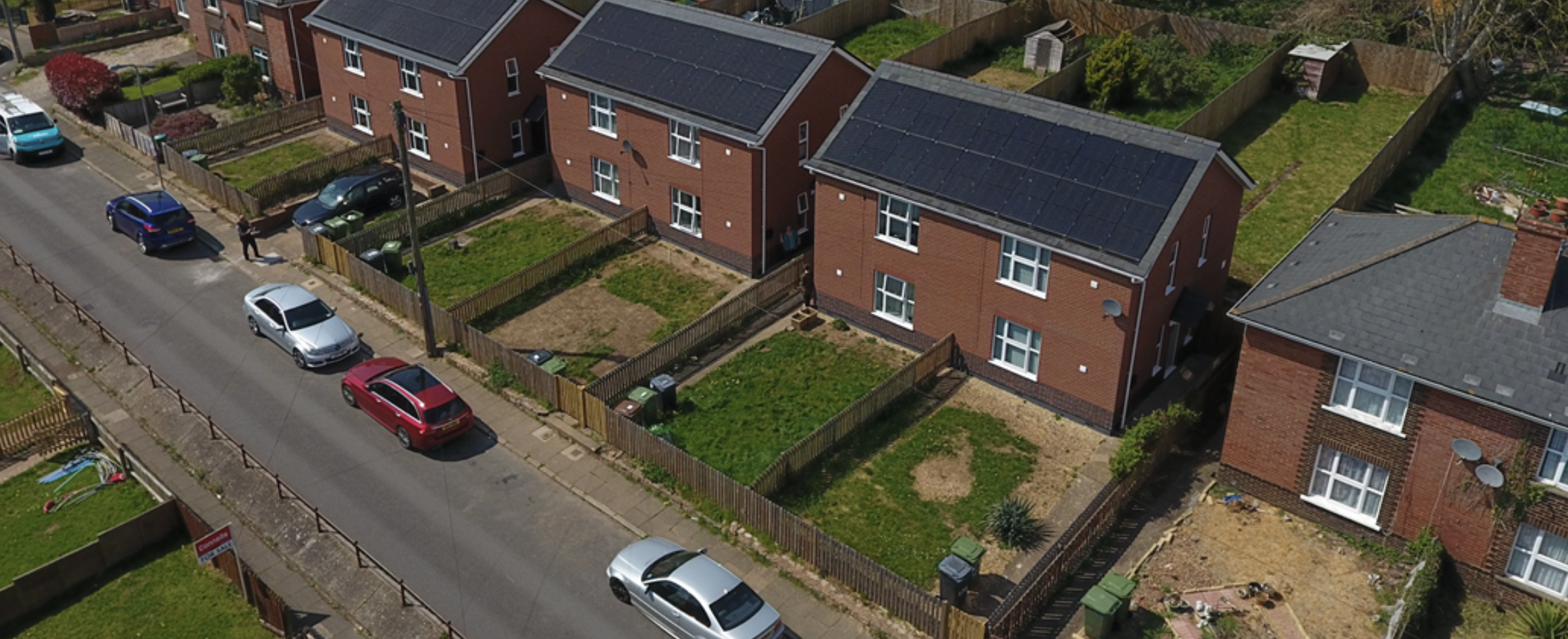Walk the Line: Emily Braham from Energiesprong UK
We caught up with Emily Braham, Director at Energiesprong UK, to talk about a revolutionary approach for whole-house refurbishment, which is manufactured offsite, and delivers net-zero energy solutions to the social housing sector.
Emily Braham
Director and Head of Strategy and Operations
Energiesprong UK
Listen to the interview here, or read on below..
Could you tell us a little bit about yourself, Emily?
I work with Energiesprong UK and we are a market development team.
Our role is working on improving the retrofit market in the UK, particularly focusing on how we create a market that works for offsite, and speeds up retrofit to tackle the huge challenge that is the 2050 net zero target for homes.
How does the market development aspect work in practice?
We’re working with social housing organisations to build demand in such a way that the construction industry, and ideally the manufacturing industry too, can respond to that demand in a different way that helps us to scale retrofit. To meet the UK’s 2050 target for homes, we've got to do two homes per minute. Though, every minute that we're not doing that, the number goes up.
Examples of homes after an Energiesprong UK retrofit
We're addressing some of the challenges that currently exist in retrofit; it's a whole-house retrofit model which requires a performance guarantee. Landlords don't mind what the detail specification is, what they do mind is how the home performs after it's been retrofitted, for example, what tenant energy bills will be and what the maintenance is going to look like.
We’ve taken a model which was developed in the Netherlands: a self-financing approach to retrofitting and also new builds. This involves improving the energy and carbon performance of a home at no extra cost to the landlord or to the occupier, instead it was funded by the Dutch government. The model is based on the Dutch energy market where if a home generates as much energy as it uses over a year, then there is a zero bill.
“The money that the tenant would’ve paid on their energy bills, can be used to fund the cost of the retrofit – necessitating the need for a performance guarantee.”
This performance guarantee is ensured by a solution provider, who is responsible for designing, building and then guaranteeing the performance and maintenance of the home over a long period.
From the landlord’s perspective, they would have budgeted a specific amount for the home over 30 years, replacing things like the roof or windows, so by picking homes that are at the right point in the investment cycle, the budget will then be spent on the retrofit. By spending the money that the tenant and landlord are saving, you create a business case and an investment envelope that enables you to get to a net zero retrofit.
Seven years ago, we asked ourselves how we could make this work in the UK, because it tackles a lot of the challenges that we see here: supply and quality issues, labour shortages, relying on grants, and disruption to tenants when construction is slow and messy.
What were the challenges with bringing this to the UK?
The first one is that the zero-bill model doesn't exist here, and even when initiatives appear they aren’t around very long. This means it’s harder for the guarantee to be clear. To make the model work around this, in the UK we have to use different technologies, for example we need battery storage and monitoring equipment for controlling usage. We've been working with both Octopus Energy and Ilke Homes on this because the zero-bills model is a great proposition for sale housing, or for shared ownership where the person that is paying for the investment actually sees the benefit.
“Another of the challenges in social housing is that there is a split incentive: the landlord pays for the cost of the work and then the resident sees the benefit.”
Whilst social landlords are concerned about making sure that people do have an affordable bill during the energy crisis, it's not affordable to retrofit all of these homes if there isn't a way of addressing this split incentive. The Dutch Energiesprong model includes something called the comfort plan. The resident pays a flat rate fee for their comfort, such as having a specific amount of heating or hot water. In the UK on top of that, there is still an energy bill – but if Octopus (or a similar organisation) can control the equipment inside the property to drive the residual cost down, then the proposition becomes much clearer for all of those involved.
But, in order to do that we have to tackle a number of technology and process challenges. We’ve been lucky enough recently to secure some Heat Pump Ready funding to tackle regulatory challenges. This feeds into our developing this end-to-end comfort plan proposition, working with some software providers and some service providers. We've already developed a contract, which is a consumer contract for the comfort plan. But, further to that, how do we make that more robust? How do we link it to the energy meter? How do we look at whether that could be incorporated into rents instead? The other challenge is the software. How do we actually make it work in the best way for all of the different users? How do we get the right data to the right people?
Could you tell us a little bit about the technology?
It does depend a bit on the property and also where it is located. In essence, we're aiming to get to a situation where the home is insulated to achieve a performance outcome of around 30–40 kilowatt hours per metre squared, which is quite high performance, and one that is achieved through offsite manufacturing. We require the solution providers to deliver their solutions within 15 days on site, in that time, they need to wrap the whole home and provide all of the energy equipment. This time constraint drives the offsite manufacturer and makes the process more appealing to the landlords and tenants. We are actively working with organisations who are developing energy modules in this way, which contain heat pumps, have battery and thermal storage etc.
An energy module going into place
What has the feedback been like from residents?
I think it's necessary to say that the first pilot in Nottingham still took quite a long time. I also think our expectations were probably quite high of how developed the industry was in the UK at the time, so we probably didn't prepare them as well as we could have for the fact that it was going to be quite a lengthy process of preparation ready for these panels to be flown on with cranes – but, they were really good about it.
“Because they were the first pilot, I think they were quite excited and they worked as a bit of a team with the solution provider and with us. The feedback around the warmth and comfort they had after the project was fantastic.”
Particularly in Nottingham, where the same solution provider and housing provider partnership has continued, and they are now on a fifth phase of work, doing 80 homes. Each time they've made the process much more efficient; they're now insulating a whole terrace in a day, with tenants not ever needing to leave their homes (apart from the short period the crane travels over the home).
For a lot of tenants, although they're happy with how warm their homes are, it's the little extras that make retrofit appealing, because it has improved their home rather than compromised it. For example, having extra window space and a bit of extra floor space because the facades are put on the outside.
How has it been for the offsite partners that you work?
Initially, we had a group of social landlords who said, "Yes, we're really interested in doing this, we'd like to commit." But, every project we procured with them was separate because of the UK’s procurement requirements.
In order to make the model work here in the UK, we sat down with partners Turner & Townsend and the GLA who were funding the Retrofit Accelerator for Homes programme under the Mayor of London to work out how we could make this volume something that's actually real for the supply chain, so that we could start to get interest from these manufacturers who need to invest in different solutions. Together, we came up with a process called an innovation partnership, a relatively new procurement approach which enables you to procure something which doesn't yet exist. We quickly realised that the solutions didn't exist, and what we should have procured was a partner to develop the solutions. So that is what the innovation partnership is, it is about working to develop these solutions. After they work through prototyping and the pilot phase, there is a £10 billion framework, where any social housing landlord can buy these net zero retrofit solutions through this framework.
Do you think there could be anything born for the private sector out of this?
We do get a lot of interest from that space, and we are keen to service those private residents in the future. But at the moment, in order to create large-scale market appeal, we're focusing on landlords who have a lot of replicable properties and also focus on the type of properties which are easily retrofitted using offsite solutions.
Lots of the properties we currently work on are social housing and were built after the war during the emergency manufacturing programme, meaning they were built offsite in the first place and really suit our offsite retrofit solution. For us, it made sense to begin simple and then as the solutions improve, start to branch out into some of those more complex, bespoke properties. Also, in terms of the financial model, there are differences for private residents. For example, renovations aren’t typically budgeted for and instead will be quite sporadic across a 30-year period – so it is an interesting challenge.
Looking ahead, what projects are you excited about at the moment?
We've got five projects in the innovation partnership that have just been signed off, so it will be really exciting to see those come to site this spring and see how much momentum we can build. I think the Heat Pump Ready project that we've got running to crack this comfort plan, is going to be great, too.
The other thing that we are all excited about is having just concluded the first performance review of the pilots and subsequently launched the first performance report. Of around 173 homes that are completed or almost completed, we've had four years of data for 69 of them. After the winter, we'll be able to do an update on that and then we'll start to see those numbers increase.
“The report is showing such high levels of performance, proving to us that having a performance guarantee, which is a real shift in the UK, has really focused the efforts of those designers and solution providers to make sure that the homes do what they are expected to.”
And to end, who are you passing the mic to next?
“I’m passing the mic to Andrew Thomson at Ultrapanel. Andrew was Chief Designer at Dyson, but is now Technical Director at Ultrapanel. They're prototyping their first retrofit solution on an Energiesprong project in London”




